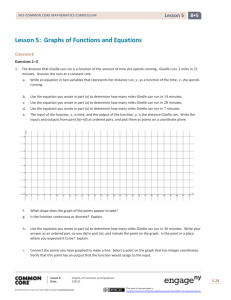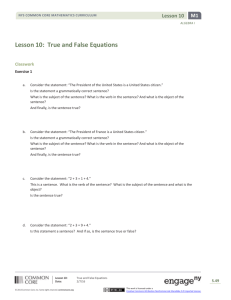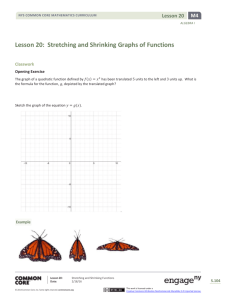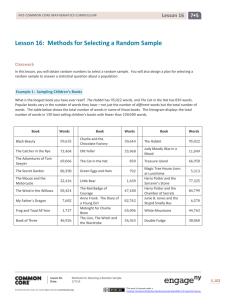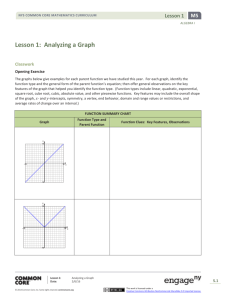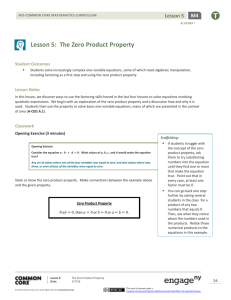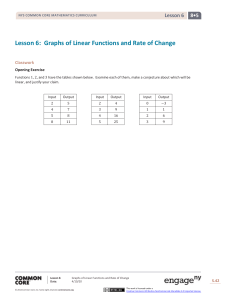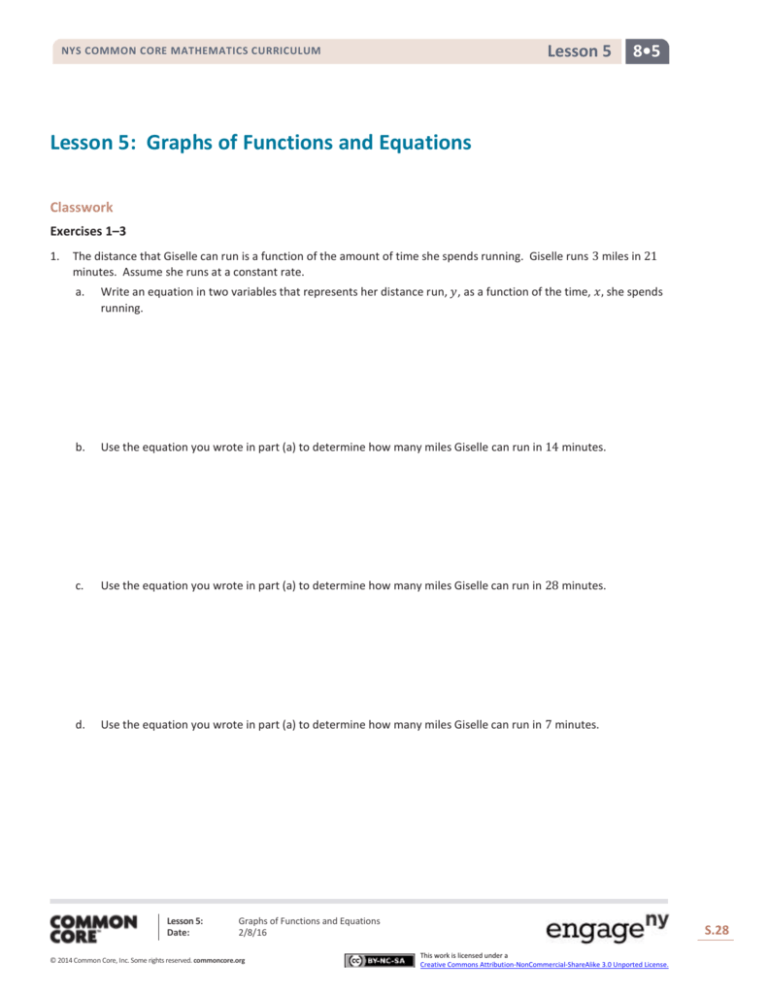
Lesson 5
NYS COMMON CORE MATHEMATICS CURRICULUM
8•5
Lesson 5: Graphs of Functions and Equations
Classwork
Exercises 1–3
1.
The distance that Giselle can run is a function of the amount of time she spends running. Giselle runs 3 miles in 21
minutes. Assume she runs at a constant rate.
a.
Write an equation in two variables that represents her distance run, 𝑦, as a function of the time, 𝑥, she spends
running.
b.
Use the equation you wrote in part (a) to determine how many miles Giselle can run in 14 minutes.
c.
Use the equation you wrote in part (a) to determine how many miles Giselle can run in 28 minutes.
d.
Use the equation you wrote in part (a) to determine how many miles Giselle can run in 7 minutes.
Lesson 5:
Date:
Graphs of Functions and Equations
2/8/16
© 2014 Common Core, Inc. Some rights reserved. commoncore.org
S.28
This work is licensed under a
Creative Commons Attribution-NonCommercial-ShareAlike 3.0 Unported License.
NYS COMMON CORE MATHEMATICS CURRICULUM
Lesson 5
8•5
e.
The input of the function, 𝑥, is time, and the output of the function, 𝑦, is the distance Giselle ran. Write the
inputs and outputs from parts (b)–(d) as ordered pairs, and plot them as points on a coordinate plane.
f.
What shape does the graph of the points appear to take?
g.
Is the function continuous or discrete?
h.
Use the equation you wrote in part (a) to determine how many miles Giselle can run in 36 minutes. Write your
answer as an ordered pair, as you did in part (e), and include the point on the graph. Is the point in a place
where you expected it to be? Explain.
Lesson 5:
Date:
Graphs of Functions and Equations
2/8/16
© 2014 Common Core, Inc. Some rights reserved. commoncore.org
S.29
This work is licensed under a
Creative Commons Attribution-NonCommercial-ShareAlike 3.0 Unported License.
Lesson 5
NYS COMMON CORE MATHEMATICS CURRICULUM
8•5
i.
Assume you used the rule that describes the function to determine how many miles Giselle can run for any
given time and wrote each answer as an ordered pair. Where do you think these points would appear on the
graph?
j.
What do you think the graph of this function will look like? Explain.
k.
Connect the points you have graphed to make a line. Select a point on the graph that has integer coordinates.
Verify that this point has an output that the function would assign to the input.
l.
Sketch the graph of the equation 𝑦 = 𝑥 using the same coordinate plane in part (e). What do you notice
1
7
about the graph of the function that describes Giselle’s constant rate of running and the graph of the equation
1
7
𝑦 = 𝑥?
Lesson 5:
Date:
Graphs of Functions and Equations
2/8/16
© 2014 Common Core, Inc. Some rights reserved. commoncore.org
S.30
This work is licensed under a
Creative Commons Attribution-NonCommercial-ShareAlike 3.0 Unported License.
Lesson 5
NYS COMMON CORE MATHEMATICS CURRICULUM
2.
8•5
Sketch the graph of the equation 𝑦 = 𝑥 2 for positive values of 𝑥. Organize your work using the table below, and
then answer the questions that follow.
𝒙
𝒚
0
1
2
3
4
5
6
a.
Plot the ordered pairs on the coordinate plane.
Lesson 5:
Date:
Graphs of Functions and Equations
2/8/16
© 2014 Common Core, Inc. Some rights reserved. commoncore.org
S.31
This work is licensed under a
Creative Commons Attribution-NonCommercial-ShareAlike 3.0 Unported License.
Lesson 5
NYS COMMON CORE MATHEMATICS CURRICULUM
8•5
b.
What shape does the graph of the points appear to take?
c.
Is this equation a linear equation? Explain.
d.
An area function 𝐴 for a square with length of a side 𝑠 has the rule so that it assigns to each input an output,
the area of the square, 𝐴. Write the rule for this function.
e.
What do you think the graph of this function will look like? Explain.
f.
Use the function you wrote in part (d) to determine the area of a square with side length 2.5. Write the input
and output as an ordered pair. Does this point appear to belong to the graph of 𝑦 = 𝑥 2 ?
Lesson 5:
Date:
Graphs of Functions and Equations
2/8/16
© 2014 Common Core, Inc. Some rights reserved. commoncore.org
S.32
This work is licensed under a
Creative Commons Attribution-NonCommercial-ShareAlike 3.0 Unported License.
NYS COMMON CORE MATHEMATICS CURRICULUM
3.
Lesson 5
8•5
The number of devices a particular manufacturing company can produce is a function of the number of hours spent
making the devices. On average, 4 devices are produced each hour. Assume that devices are produced at a
constant rate.
a.
Write an equation in two variables that represents the number of devices, 𝑦, as a function of the time the
company spends making the devices, 𝑥.
b.
Use the equation you wrote in part (a) to determine how many devices are produced in 8 hours.
c.
Use the equation you wrote in part (a) to determine how many devices are produced in 6 hours.
d.
Use the equation you wrote in part (a) to determine how many devices are produced in 4 hours.
Lesson 5:
Date:
Graphs of Functions and Equations
2/8/16
© 2014 Common Core, Inc. Some rights reserved. commoncore.org
S.33
This work is licensed under a
Creative Commons Attribution-NonCommercial-ShareAlike 3.0 Unported License.
NYS COMMON CORE MATHEMATICS CURRICULUM
Lesson 5
8•5
e.
The input of the function, 𝑥, is time, and the output of the function, 𝑦, is the number of devices produced.
Write the inputs and outputs from parts (b)–(d) as ordered pairs, and plot them as points on a coordinate
plane.
f.
What shape does the graph of the points appear to take?
g.
Is the function continuous or discrete?
Lesson 5:
Date:
Graphs of Functions and Equations
2/8/16
© 2014 Common Core, Inc. Some rights reserved. commoncore.org
S.34
This work is licensed under a
Creative Commons Attribution-NonCommercial-ShareAlike 3.0 Unported License.
Lesson 5
NYS COMMON CORE MATHEMATICS CURRICULUM
8•5
h.
Use the equation you wrote in part (a) to determine how many devices are produced in 1.5 hours. Write your
answer as an ordered pair, as you did in part (e), and include the point on the graph. Is the point in a place
where you expected it to be? Explain.
i.
Assume you used the rule that describes the function to determine how many devices are produced for any
given time and wrote each answer as an ordered pair. Where do you think these points would appear on the
graph?
j.
What do you think the graph of this function will look like? Explain.
k.
Connect the points you have graphed to make a line. Select a point on the graph that has integer coordinates.
Verify that this point has an output that the function would assign to the input.
l.
Sketch the graph of the equation 𝑦 = 4𝑥 using the same coordinate plane in part (e). What do you notice
about the graph of the function that describes the company’s constant rate of producing devices and the graph
of the equation 𝑦 = 4𝑥?
Lesson 5:
Date:
Graphs of Functions and Equations
2/8/16
© 2014 Common Core, Inc. Some rights reserved. commoncore.org
S.35
This work is licensed under a
Creative Commons Attribution-NonCommercial-ShareAlike 3.0 Unported License.
NYS COMMON CORE MATHEMATICS CURRICULUM
Lesson 5
8•5
Exploratory Challenge/Exercise 4
4.
Examine the three graphs below. Which, if any, could represent the graph of a function? Explain why or why not for
each graph.
Graph 1:
Graph 2:
Lesson 5:
Date:
Graphs of Functions and Equations
2/8/16
© 2014 Common Core, Inc. Some rights reserved. commoncore.org
S.36
This work is licensed under a
Creative Commons Attribution-NonCommercial-ShareAlike 3.0 Unported License.
NYS COMMON CORE MATHEMATICS CURRICULUM
Lesson 5
8•5
Graph 3:
Lesson 5:
Date:
Graphs of Functions and Equations
2/8/16
© 2014 Common Core, Inc. Some rights reserved. commoncore.org
S.37
This work is licensed under a
Creative Commons Attribution-NonCommercial-ShareAlike 3.0 Unported License.
Lesson 5
NYS COMMON CORE MATHEMATICS CURRICULUM
8•5
Lesson Summary
The inputs and outputs of a function can be written as ordered pairs and graphed on a coordinate plane. The graph
of a function is the same as the rule (equation) that describes it. For example, if a function can be described by the
equation 𝑦 = 𝑚𝑥, then the ordered pairs of the graph are (𝑥, 𝑚𝑥), and the graph of the function is the same as the
graph of the equation, 𝑦 = 𝑚𝑥.
One way to determine if a set of data is a function or not is by examining the inputs and outputs given by a table. If
the data is in the form of a graph, the process is the same. That is, examine each coordinate of 𝑥 and verify that it
has only one 𝑦 coordinate. If each input has exactly one output, then the graph is the graph of a function.
Problem Set
1.
1
The distance that Scott walks is a function of the time he spends walking. Scott can walk mile every 8 minutes.
2
Assume he walks at a constant rate.
a.
Predict the shape of the graph of the function. Explain.
b.
Write an equation to represent the distance that Scott can walk, 𝑦, in 𝑥 minutes.
c.
Use the equation you wrote in part (b) to determine how many miles Scott can walk in 24 minutes.
d.
Use the equation you wrote in part (b) to determine how many miles Scott can walk in 12 minutes.
e.
Use the equation you wrote in part (b) to determine how many miles Scott can walk in 16 minutes.
f.
Write your inputs and corresponding outputs as ordered pairs, and then plot them on a coordinate plane.
g.
What shape does the graph of the points appear to take? Does it match your prediction?
h.
If the function that represents Scott’s walking is continuous, connect the points to make a line, and then write
the equation that represents the graph of the function. What do you notice?
Lesson 5:
Date:
Graphs of Functions and Equations
2/8/16
© 2014 Common Core, Inc. Some rights reserved. commoncore.org
S.38
This work is licensed under a
Creative Commons Attribution-NonCommercial-ShareAlike 3.0 Unported License.
NYS COMMON CORE MATHEMATICS CURRICULUM
2.
Lesson 5
8•5
Graph the equation 𝑦 = 𝑥 3 for positive values of 𝑥. Organize your work using the table below, and then answer the
questions that follow.
𝑥
𝑦
0
0.5
1
1.5
2
2.5
a.
Plot the ordered pairs on the coordinate plane.
b.
What shape does the graph of the points appear to take?
c.
Is this the graph of a linear function? Explain.
d.
A volume function has the rule so that it assigns to each input, the length of one side of a cube, 𝑠, and to the
output, the volume of the cube, 𝑉. The rule for this function is 𝑉 = 𝑠 3 . What do you think the graph of this
function will look like? Explain.
e.
Use the function in part (d) to determine the volume with side length of 3. Write the input and output as an
ordered pair. Does this point appear to belong to the graph of 𝑦 = 𝑥 3 ?
Lesson 5:
Date:
Graphs of Functions and Equations
2/8/16
© 2014 Common Core, Inc. Some rights reserved. commoncore.org
S.39
This work is licensed under a
Creative Commons Attribution-NonCommercial-ShareAlike 3.0 Unported License.
NYS COMMON CORE MATHEMATICS CURRICULUM
3.
Lesson 5
8•5
Sketch the graph of the equation 𝑦 = 180(𝑥 − 2) for whole numbers. Organize your work using the table below,
and then answer the questions that follow.
𝑥
𝑦
3
4
5
6
a.
Plot the ordered pairs on the coordinate plane.
b.
What shape does the graph of the points appear to take?
c.
Is this graph a graph of a function? How do you know?
d.
Is this a linear equation? Explain.
e.
The sum of interior angles of a polygon has the rule so that it assigns each input, the number of sides, 𝑛, of the
polygon, and to the output, 𝑆, the sum of the interior angles of the polygon. The rule for this function is
𝑆 = 180(𝑛 − 2). What do you think the graph of this function will look like? Explain.
f.
Is this function continuous or discrete? Explain.
Lesson 5:
Date:
Graphs of Functions and Equations
2/8/16
© 2014 Common Core, Inc. Some rights reserved. commoncore.org
S.40
This work is licensed under a
Creative Commons Attribution-NonCommercial-ShareAlike 3.0 Unported License.
NYS COMMON CORE MATHEMATICS CURRICULUM
Lesson 5
4.
Examine the graph below. Could the graph represent the graph of a function? Explain why or why not.
5.
Examine the graph below. Could the graph represent the graph of a function? Explain why or why not.
6.
Examine the graph below. Could the graph represent the graph of a function? Explain why or why not.
Lesson 5:
Date:
8•5
Graphs of Functions and Equations
2/8/16
© 2014 Common Core, Inc. Some rights reserved. commoncore.org
S.41
This work is licensed under a
Creative Commons Attribution-NonCommercial-ShareAlike 3.0 Unported License.



